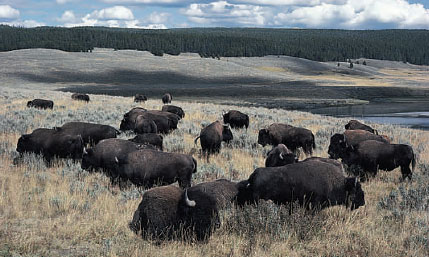General Zoology / The Animal and Its Environment
Grassland
Grassland
 |
| Figure 39-9 Bison grazing on a short-grass prairie. |
The North American prairie biome is
one of the most extensive grasslands
in the world, extending from the
Rocky Mountain edge on the west to
the eastern deciduous forest on the
east, and from northern Mexico in the
south to the Canadian provinces of
Alberta, Saskatchewan, and Manitoba
in the north. The original grassland
associations of plants and animals
have been almost completely
destroyed by humans. The prairies
today have been transformed into the
most productive agricultural region in
the world, dominated by monocultures
of cereal grains. In grazing lands
virtually all the major native grasses
have been replaced by alien species.
Vast areas of Arizona and New Mexico
have been converted from lush grasslands
to parched desert by more than
a century of livestock overgrazing. Of
the once dominant herbivore, bison
(Figure 39-9), very few survive, but
jackrabbits, prairie dogs, ground squirrels,
and antelope remain. Mammalian
predators include coyotes, ferrets, and
badgers, although, of these, only coyotes
are common. Rainfall on the
North American prairie ranges from
about 80 cm (31 inches) in the east to
40 cm (16 inches) in the west. Average
annual temperatures range between
10° and 20° C (50° to 68° F).
Support our developers

More in this section





